Random Access Memory
graduation show, Academy of Fine Arts Munich, 2024
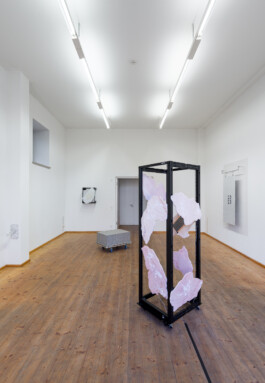
Random Access Memory
Rosanna Marie Pondorf conceptualizes a mode of encountering her art based on random access memory (RAM). As both the title of her graduation exhibition and the name of computational hardware, RAM enables the quick storage and execution of instructions on open software for users working on laptops or cellphones. This continuously requires accessible locations on the computer’s short-term memory for fast processing speeds and optimal performance.
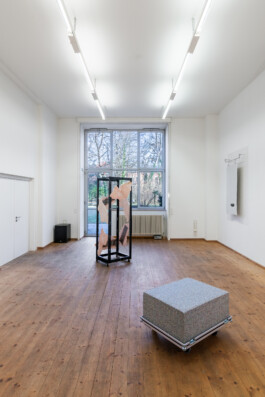
Pondorf repurposes this electronic variant of working memory onto viewers’ engagement with her six graduation artworks, arranged into three corresponding pairs. By emphasizing the cognitive effort required to perceive and understand the connections among these artworks, their subject matter become like open windows running parallel to one another. Similar to RAM, the short-term memory of viewers not only maintains relational connections among the distribution of the artworks in space but also provides a lens through which the show’s layered meanings can be accessed and processed. One such layer delves into the impact of digital technologies as operative extensions of our bodies and brains. The conceptual focus on the labor created in RAM by working on laptops implicates the conditions of late capitalism in which humans’ productive output, as well as their daily lives and livelihoods, are measured against the perfect machinic performance of computers.
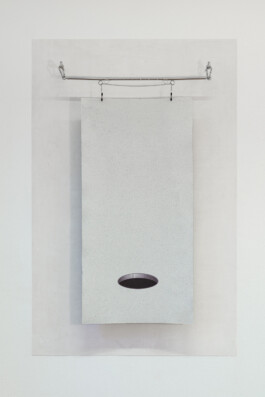
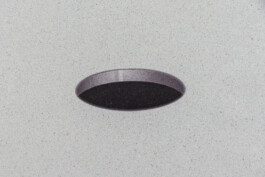
Wertschöpfungspapier [hole]
2024
uv print on handmade paper from devalued euro notes, spreader bar, nipple clamps, carabiner, eyebolt, plaster
130 x 200 x 15 cm
Bracketing Random Access Memory on opposite walls are two human-sized prints suspended like paper bodies from stainless steel spreader bars and nipple clamps. While their hanging from sex toys used in the erotic practice of BDSM considers subjugation under capitalism, the chains emoji on Wertschöpfungspapier [chains] situates these power dynamics in relation to data chains and the bondage between digital norms and capitalist values. Furthermore, the emojis’ pixelated forms on handcrafted paper made from devalued Euro bills appear sharp in its critique of the high licensing fees of something as ordinary and ubiquitous as emojis. Wertschöpfungspapier [hole]’s depiction of the hole emoji characterizes the internet as a rabbit hole of endless media content and information.
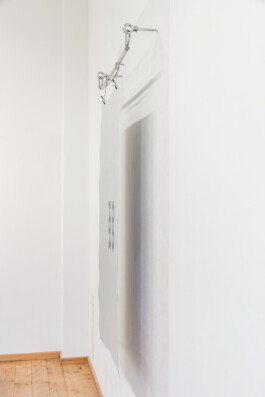
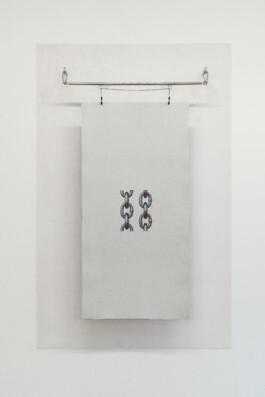
Wertschöpfungspapier [chains]
2024
uv print on handmade paper from devalued euro notes, spreader bar, nipple clamps, carabiner, eyebolt, plaster
130 x 200 x 15 cm
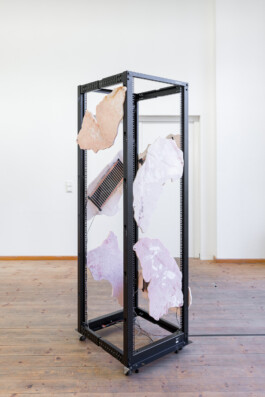
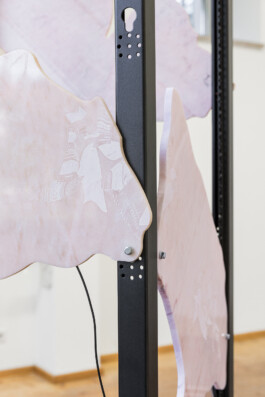
Datenkörper [enabled core]
2024
laser engraving on marble, server rack, screenshots, infrared heating foil
60x62x200 cm
However, the artist first thinks through materials before she shapes the form of her subject matter. Datenkörper [enabled core] sets mass media content in traditional sculptural materials like steel and marble. Archived within the black metal frame of a tall server rack are flesh-colored marble slabs engraved with screenshots of news articles from November 2023 until January 2024. Datenkörper [enabled kim], however, directs a marble slab inscribed with headlines about Kim Kardashian at the viral media shared online. Pondorf solidifies the fleeting and superficial tabloid content of the internet celebrity’s scandals and sexualized image into stone. As a valuable material substrate, screenshot-engraved marble brings the permanent storage and volume of trivial digital information into critical view.
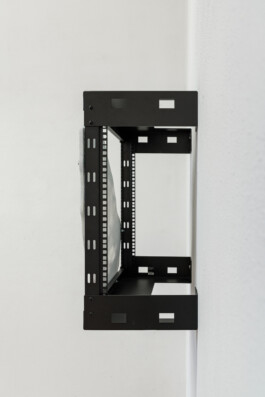
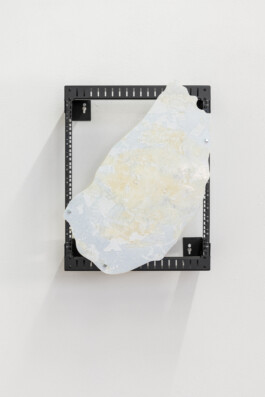
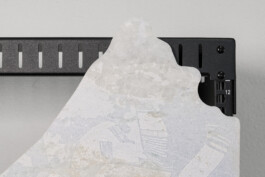
Datenkörper [enabled kim]
2024
laser engraving on marble, server rack, screenshots
20 x 30 x64 cm

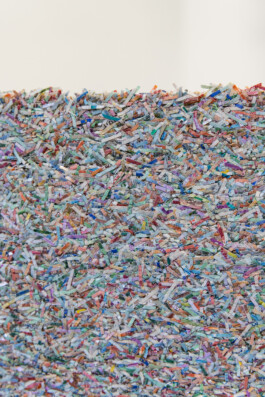
big boy [massive]
2022
devalued euro notes, sugar, flightcase
60 x 80 x 55 cm
big boy [massive] is a block of shredded, de-valued Euro bills that was pressed under 100 tons of pressure to form a 300 kg mass. In contrast to its size and weight, the smaller and lighter sculpture Pointer, touches on consumers subjugation in late capitalism. A quote from the philosopher and queer theorist Paul B. Preciado’s book Testo Junkie (2008) inscribes the marble slab. “Pharmacopornographic biocapitalism does not produce things. It produces mobile ideas, living organs, symbols, desires, chemical reactions, and conditions of the soul” swirls around Pointer’s protruding hand dildo. Pondorf bought the sex toy from Amazon, a corporation selling everything from e-commerce, digital streaming, cloud computing to AI products and services. For both Preciado and Pondorf, instead of retailing objects, it is the construction and control of consumers’ subjectivity that is open for business.
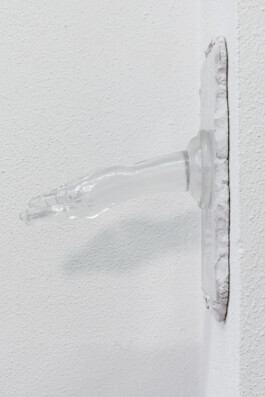
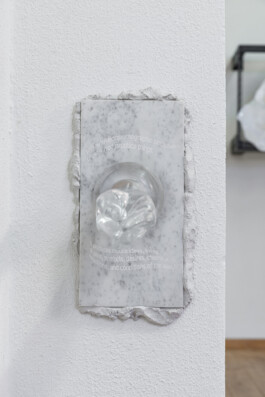
pointer
2022
laser engraving on marble, quote by Paul B. Preciado, hand dildo (silicone), tile adhesive
15 x 30 x 22 cm
In Random Access Memory the quick retrieval of information from RAM aligns with the immediate impact that certain works can have, provoking instant reactions or contemplations. To prompt this, Pondorf also renders power dynamics as palpable sound. Basal tones emanating from an undetectable position harbor frequencies that cause the space and its bodies to feel its deep vibrations. As a spatial-enveloping element, [base] transfers the push notifications of 11 different apps from the artist’s phone into a 24-minute sound piece. Produced in collaboration with the artist Kalas Liebfried, each minute represents an hour of Pondorf’s workday as it is accompanied by her cellphone. The constant connection enforced by digital technology is sensed through the unnerving, sonic experience of the invisible yet audible dominance of bass over the room’s perceiving bodies. This is an audio-spatial allegory for power under late capitalism that is felt more than it is seen or heard. As a result, the room is held in a state of tension through these deep tones suggestive of the unseeable, market forces that we feel yet cannot truly locate. Random Access Memory is not only a space vibrating with the sounds of push notifications, but its artworks also notify how the digital reverberates through our bodies and lives. Therefore, they serve as reminders that digital culture’s effects should linger a little more critically in our short-term memory before we accept its lasting impacts, by committing them to our collective, long-term memory. [Zakirah Rabaney]
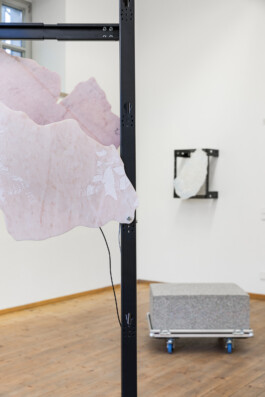
the marble was generously sponsored by HUBER Naturstein
[photo] Dirk Tacke